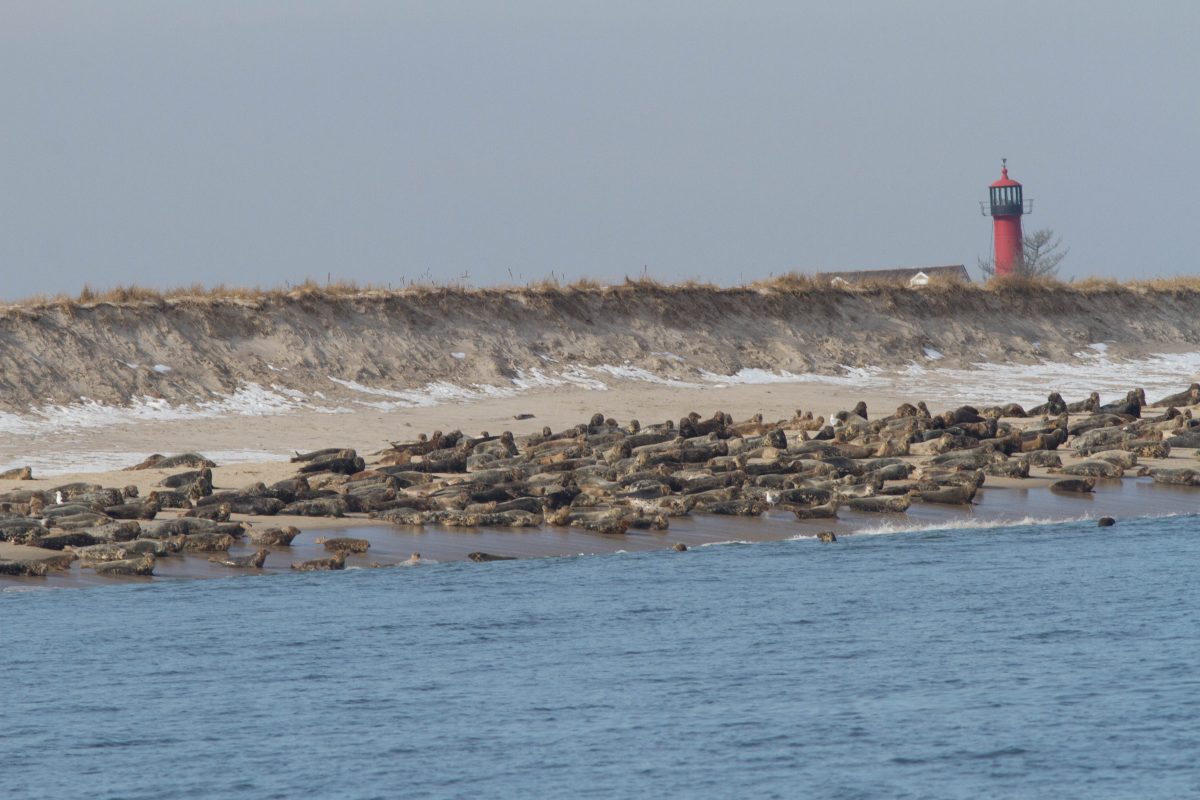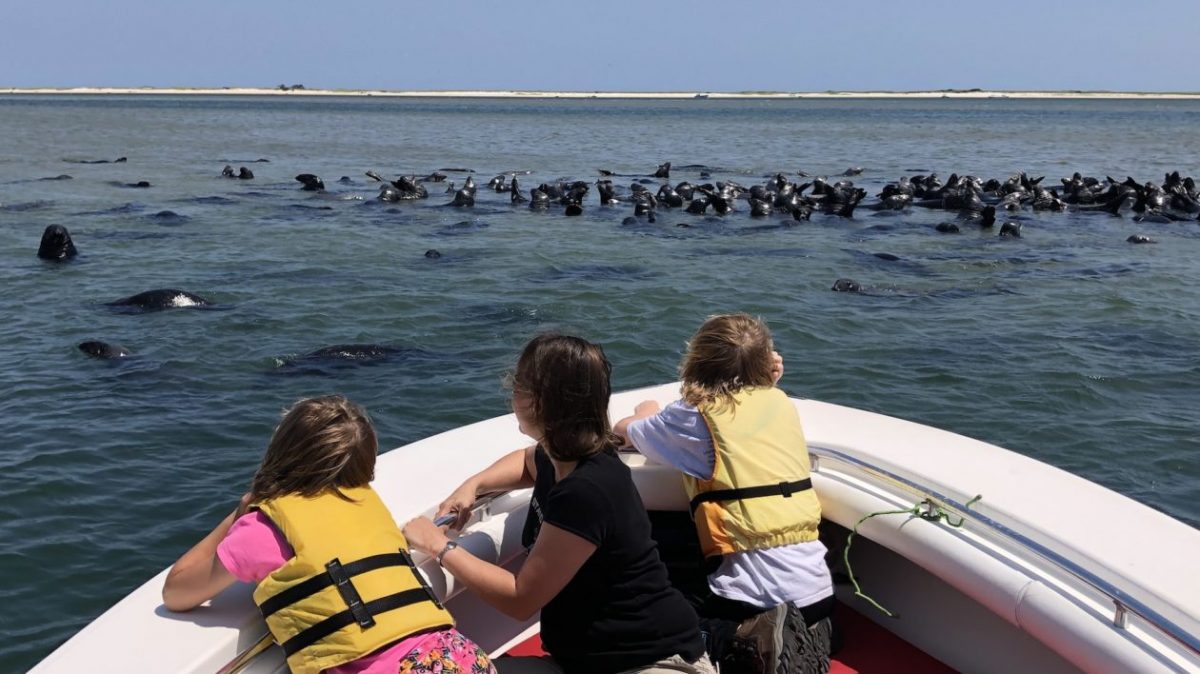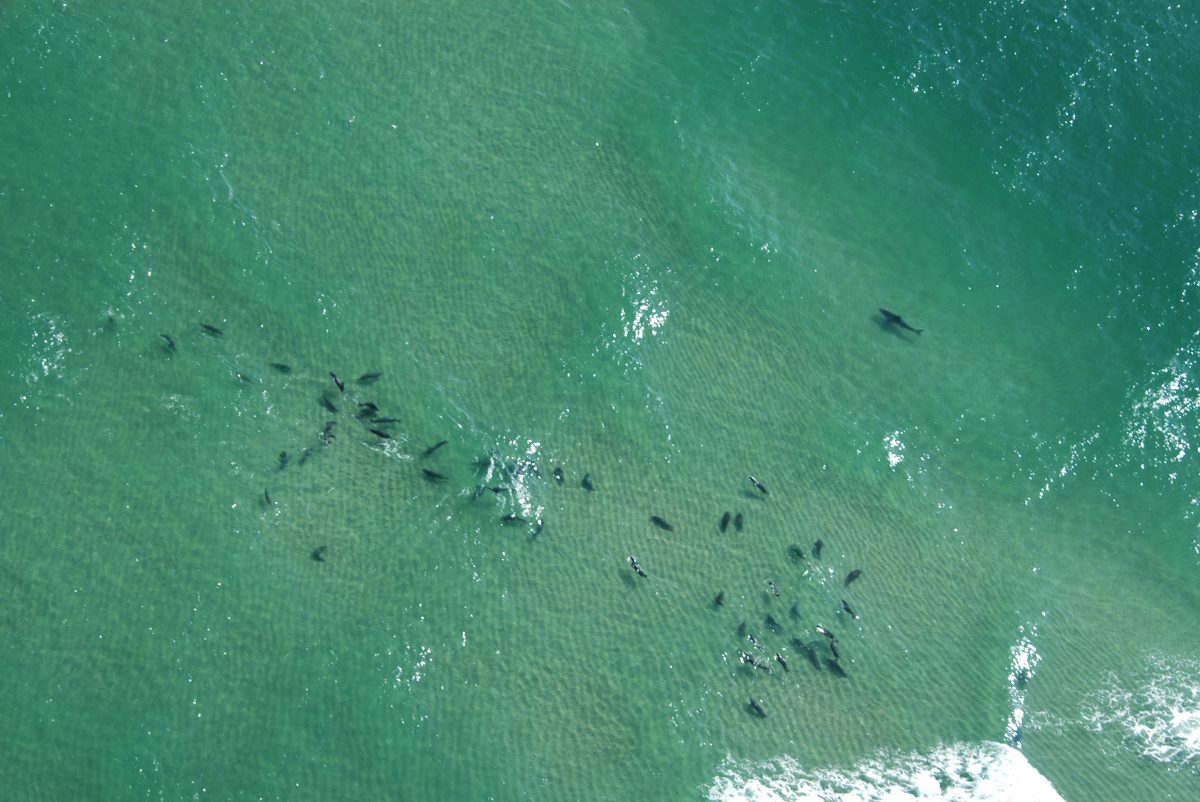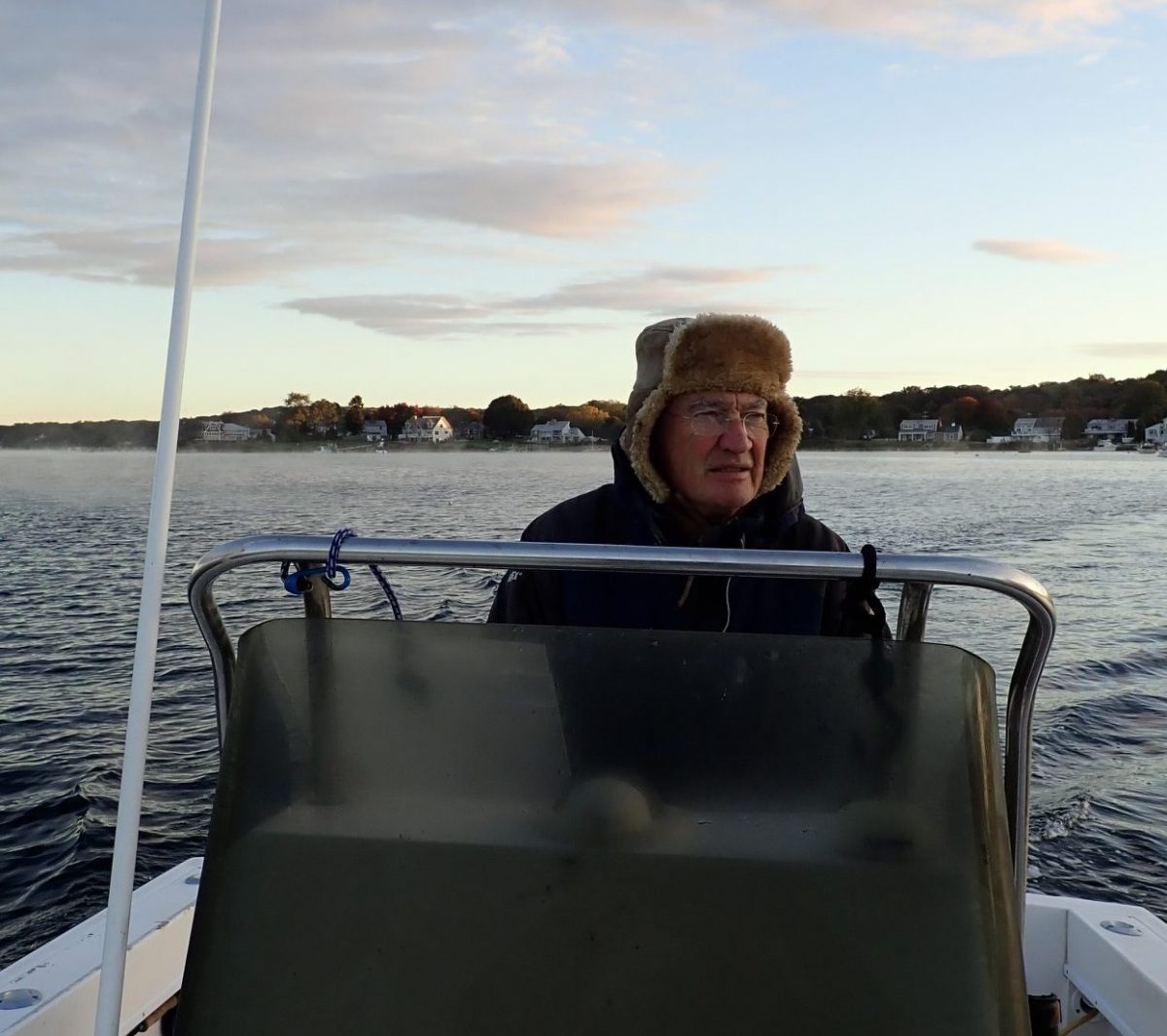Originally published on Cool Green Science, the conservation science blog of The Nature Conservancy.
On a fine, gusty June morning I hooked the striped bass of a lifetime off Monomoy National Wildlife Refuge, a designated federal wilderness at the elbow of Cape Cod.
For 50 minutes we played give and take with 150 yards of green backing. When the yellow fly line finally showed, a gray seal popped up 40 feet from my boat with the fish in his mouth. I could have sworn he grinned at me. It was all a game.
My “striper of a lifetime” turned out to be barely over the 28-inch minimum length limit. As a final insult the seal dropped it. At least I got to eat the fish. Hungrier seals leave anglers nothing.
The several thousand gray seals hauled out on the beach looked like a rock jetty. Even from a quarter mile offshore, I could smell them — a musky stench reminiscent of old fish and moldering kelp.
So many seals have returned to Nantucket’s Great Point that surfcasters can’t get a fish past them.
What’s more, the seals are attracting their traditional predators, great white sharks.

Since 2012, three people have been bitten by great whites at the Cape, including Arthur Medici, 26, who bled to death on Sept. 15, 2018. This was Massachusetts’ first shark fatality in 72 years.
Straight Out Of Jaws
Twelve days later some 300 people packed a school gymnasium in Wellfleet in a hearing described by the Boston Globe as “straight out of the 1975 film Jaws.” Public comments quoted by the paper include the following:
“The seal population is out of control. They’re eating our fish and now [the sharks] are eating our children.”
“They [government officials] are collectively responsible for the death of Arthur Medici. We have the right to swim in the water and feel safe… We need to remove those white sharks.”
And: “We have much to lose in tourism, house prices, enjoyment of the ocean. I like going to the beach and I feel infringed on my right to do so by a lesser animal.”
Even before the fatality, Barnstable County Commissioner Ron Beaty, was demanding shark control via baited hooks attached to floating drums and scolding bureaucrats for ignoring public safety. He calls for amending the Marine Mammal Protection Act to allow killing seals which, he proclaims, are “overpopulated.”
“As a … Massachusetts resident, I hate to see that ‘conserving’ sharks is more important than the interests of humans.”
The Nantucket-based Seal Action Committee agrees, at least about seals. “The gray seal population on the beaches and shores of Cape Cod and the Islands is exploding, threatening the historical inshore fishing culture and economy of the region as well as the safety and sanitation of some of our most popular beaches,” it warns. “We believe it is time to reassert some measure of control over this population through an amendment or exception to the Marine Mammal Protection Act which would require management of the gray seal population.”
Then there’s the “Atlantic Human Conservancy” (a play on the name of the Atlantic White Shark Conservancy). According to founder Karl Hoefer, seals and the sharks they attract pose “a threat to the Cape’s economy.”
“My opinion,” Hoefer wrote in a letter published by the Cape Cod Times, “is that seals should be hunted for bounty money, as they were up until 1972 [when the Marine Mammal Protection Act protected them]. I also propose that the fishing for and killing of sharks be encouraged. As an Orleans [Massachusetts] resident, I hate to see that ‘conserving’ sharks is more important than the interests of humans.”
Hoefer went on to assert that seals pollute beaches with their scat, infect humans with distemper and that: “If we continue to let the seal population, or should I say ‘poop’ulation, grow indefinitely, we won’t even be able to visit our own beaches… Again, food (or feces) for thought the next time you call a seal ‘cute.’”

The seals are snatching fish from nets (destroying them in the process); and both sharks and seals are snatching fish from lines. So seals get blamed for depleting whatever fish commercial fishermen and anglers happen to pursue.
“It’s mind-blowing that people can’t identify that we have a species that is out of control here,” Chatham, Massachusetts commercial fisherman Nick Muto told WBUR radio. “They’ve destroyed a lot of the inshore fish populations. … They’ve attracted the sharks. And they’re also polluting the waters.”
A Story of Recovery
Are gray seals “overpopulated” and “out of control”? I put the question to the Northeast Atlantic Seal Research Consortium chair, Dr. Andrea Bogomolni.
“The gray seals are healthy,” she replied. “We don’t see skinny, starving or diseased animals, which would indicate overpopulation.”
She cited studies showing that, prior to persecution, the gray seal population had greater genetic diversity, indicating that there were more individuals.
So apparently recovery is ongoing. No one knows what an “overpopulation” of seals is because no living person has ever seen a natural population. In fact, many of us grew up seeing no seals.
The last thing anyone who objects to seals should advocate is killing the predators that may one day limit them.

Before the Marine Mammal Protection Act gray and harbor seals were shot on sight. Maine and Massachusetts even paid bounties on them from 1880 to 1962.
“Conservation efforts have been incredibly successful for seals,” says Dr. Joe Roman, a conservation biologist with the Gund Institute for Environment at the University of Vermont.
The U.S. gray seal population went from zero in 1972 to somewhere between 23,000 and 27,000 in 2018. Only a few hundred harbor seals survived in the Gulf of Maine before 1972; today there may be as many of 70,000 just in U.S. waters.
Great white sharks are recovering, too. “I think the recovery is linked to the 1997 prohibition on retention [mandatory release] as well as severe regulations on longline fisheries,” says Dr. Greg Skomal, Recreational Fisheries Program Manager for the Massachusetts Division of Marine Fisheries. “Mostly they were victims of bycatch in expanding commercial longlines targeting tunas and swordfish but sharks as well.”
Is the recolonization of gray seals helping with white shark recovery? It seems likely, but confirming data aren’t in.
“Certainly sharks are responding to a resource that’s been absent for a long time. This has been amazing to watch. For some of us it’s cause for celebration.”
What’s definitely recovering, though, is the marine ecosystem. Roman offers this: “Certainly sharks are responding to a resource that’s been absent for a long time. This has been amazing to watch. For some of us it’s cause for celebration.”
Are seals depleting fish? Striper fishermen think they eat mostly stripers. Groundfish fishermen think they eat mostly groundfish. Lobster fishermen think they eat mostly lobsters. … What they really mostly eat are baitfish, especially sand lances.
The effect of seals on fisheries is complex and not necessarily negative. “They’re eating fish that eat other fish,” notes Bogomolni. “So they can actually increase some populations.”
Seals are generalists, preying on what’s most available. And, in addition to baitfish, what’s most available these days are dogfish. When commercial fishermen depleted cod, dogfish surged into that niche and to some degree are blocking cod recovery. Seals eat dogfish, too. That could help restore the natural balance.
More vociferous than all other fisher folk in blaming seals for decreasing catches are my fellow pursuers of striped bass, the most popular gamefish in the North Atlantic. The blame, however, lies with the Atlantic States Marine Fisheries Commission which has allowed the stock to be “overfished” — mostly by anglers though commercial fishermen target stripers, too. At least the Commission admits this failing and seems ready to do something about it.

In addition to being generalists, seals are opportunists. Stripers are faster than seals. Most stripers eaten by seals are struggling on the end of someone’s line or, if released, are exhausted, wounded or dead. “A seal thinks ‘Ah, a free meal,’” says Roman. “My guess is that’s part of the perception. People see that.”
What about the charge that seals pollute beaches? “That’s misinformation,” says Bogomolni. “There are fewer beach closures where seals are than where humans are. We have really terrible septic systems on Cape Cod. And seals here tend to haul out in areas with extreme tidal flow like Monomoy National Wildlife Refuge and Cape Cod National Seashore.”
When I asked her about distemper she said: “Distemper does affect seals, especially harbor seals. But seals can’t pass it to humans.”
Roman adds this: “Seals move nutrients from the bottom of the ocean toward the surface where they’re available to phytoplankton and to the coastline where they’re available to plants. Because this is a relatively new issue on Cape Cod we don’t know what it means for ecosystems, but in Antarctica and other places we see enhanced biodiversity around seal breeding sites.”
In much of America there’s another ongoing recovery: The public is coming to understand that one participates in nature on nature’s terms, that the sea and wildland are not amusement parks with full-time maintenance crews.
Are seals and sharks really “a threat to the Cape’s economy”? Precisely the opposite. Seal watching charters have become a booming industry. And the Atlantic White Shark Conservancy partners with Whale and Dolphin Conservation to run white shark watches, invariably filling the boat at $185 per head. The Conservancy also partners with Chatham Bars Inn to offer White Shark Expeditions from a smaller vessel chartered at $2,500 per trip.
Nature on Nature’s Terms
In much of America there’s another ongoing recovery: The public is coming to understand that one participates in nature on nature’s terms, that the sea and wildland are not amusement parks with full-time maintenance crews.
For example, visitors in Yellowstone and Glacier National Parks get that they enter grizzly country at their own risk. They wear bells, carry bear spray and shout “Yogi” at bends on wooded trails.
On the West Coast, where the white shark population dwarfs that of the East Coast, people get that they swim and surf at their own risk. They don’t enter the water near seals or sea lions, and they exit when lifeguards spot sharks. They don’t demand that government officials “do something” about native wildlife.
In much of the coastal Northeast, however, such thinking has yet to catch on.
No one has a “right” to be protected from nature — especially on national seashores, national wildlife refuges and federal wilderness areas.






